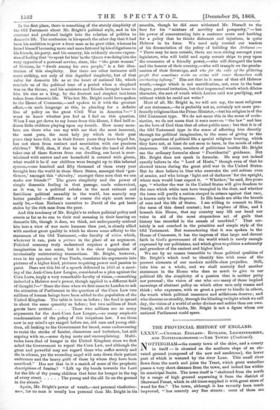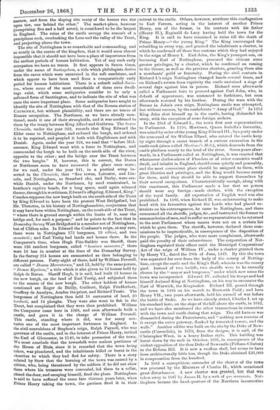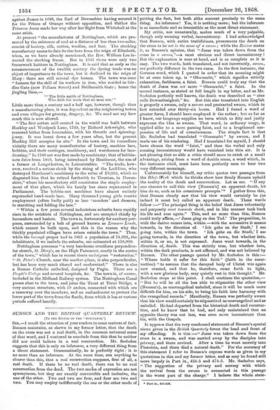THE PROVINCIAL HISTORY OF ENGLAND.
LXXXV.—CENTRAL ENGLAND : RUTLAND, LEICESTERSHIRE,
AND NOTTINGHAMSHIRE Towns (Continued).
OTTINGHAM—the county town of the shire, and a county 11 in itself — is situated on the southern slope of an ele- vated ground (composed of the new red sandstone), the lower part of which is watered by the river Lene. This small river flows from the north and joins the Trent, which great waterline- passes a very short distance from the town, and indeed lies within its municipal limits. The town itself is "sheltered from the north by a range of high ground separating it from the district of Sherwood Forest, which in old times supplied it with great store of wood for fire." The town, although it has recently been much improved, " has scarcely any fine streets ; most of them are
dismantled during the Protectorate, and " nothing now remains of it except the outer gateway, flanked by truncated towers, and the walls." Another edifice was built on the site by the Duke of New- castle (Cavendish), in 1679, from the designs, it is said, of Sir Christopher Wren, in a heavy Italian style. This building was burnt down by the mob in October, 1831, in consequence of the violent opposition of the then Duke of Newcastle (Pelham-Clinton) to the Reform Bill. It is now a roofless shell, but seems to have been architecturally little loss, though the Duke obtained £21,000 related by Stow that the burning of the town was caused by a in compensation from the hundred. citizen, who, being threatened by the soldiers if he did not show In 1682 a surreptitious surrender of the charter of the town them where his treasures were concealed, led them to a cellar, was procured by the Ministers of Charles II., which occasioned
closed the door, and escaping himself, fired the place. Nottingham great disturbances. A new charter was granted, but that WAS is said to have suffered the same fate thirteen years later, when taken away in 1687 by James II. by a writ of quo warranto. Not- Prince Henry taking the town, the garrison fired it in their . tingliam became the head-quarters of the Northern insurrection
narrow, and from the sloping site many of the houses rise tier upon tier, one behind the other." The market-place, however (comprising five and a half acres), is considered to be the largest in England. The ruins of the castle occupy the summit of a precipitous rock, overlooking the Lene and the valley of the Trent, and projecting above the town.
The site of Nottingham is so remarkable and commanding, and so nearly in the centre of the kingdom, that it would seem almost
impossible that it should not have been a place of importance from the earliest periods of human habitation. Yet of any such early occupation we have no traces. It first appears in Saxon times, under the name of Snotingeham, a title which philologists derive from the caves which were excavated in the soft sandstone, and which appear to have been used from a comparatively early period for human habitations. There is a suburb called Stiehl- ton, where some of the most remarkable of these cave dwell-
ings exist, which some antiquaries consider to be only a softened form of Snottington, and to indicate the site of what was
once the more important place. Some antiquaries have sought to identify the site of Nottingham with that of the Roman station of CAUSENN/E, but without plausibility, and there are no traces of Roman occupation. The Northmen, as we have already men- tioned, made it one of their strongholds, and it was confirmed to them by the treaty between King Alfred and Guthrum. The Saxon Chronicle, under the year 922, records that King Edward the Elder came to Nottingham, and reduced the burgh, and ordered it to be repaired, and peopled it both with Englishmen and with Danish. Again, under the year 924, we read that " before Mid- summer, King Edward went with a force to Nottingham, and commanded the burgh to be built on the south side of the river, opposite to the other ; and the bridge over the Trent between the two burghs." If, however, this is correct, the Danes or Northmen seem to have recovered the place once mere; for we read, under the year 941, in a poetical scrap in- serted in the Chronicle, that "five towns, Leicester, and Lin- coln, and Nottingham, so Stamford eke, and Derby, were ere- while Danish, under the Northmen, by need constrained, in heathen's captive bonds, for a long space, until again released thence, through his worthiness, Edward's offspring, Edmund, King." Camden supposes the new burgh built on the south side of the Trent by King Edward to have been the present West Bridgeford, but Mr. Thoroton, in his history of Nottinghamshire, conjectures that it may have been within Nottingham, on the south side of the Trent, " where there is ground enough within the limits of it, near the bridge end, for such a purpose ;" and he points to the fact that in Domesday Survey West Bridgeford is a member not of Nottingham, but of Clifton soke. In Edward the Confessor's reign, at any rate, there were in Nottingham 173 burgesses, 19 villani, and two monetarii ; and Earl Tostig had lauds and houses there. In the Conqueror's time, when Hugh Fitz-Baldric was Sheriff, there were 136 resident burgesses, called "homines manentes ;" there were 16 less in number at the time of the Domesday Survey. In the Survey 214 houses are enumerated as then belonging to different persons. Forty-eight of these, held by William Peverell, are called " Donuts Mercatorum," and 12, held by the same person, "Domes Equitum," a title which is also given to 13 houses held by Ralph de Baran. Sheriff Hugh, it is said, had built 13 houses in the new burgh, on the land of Earl Tostig, and subjected them to the census of the new burgh. The other holders of houses mentioned are Roger de Baldly, Guilbert, Ralph FitzHerbert, Geoffrey de Anselym, Acadus the priest, and Richard Tresle. The burgessses of Nottingham then held 16 carrucates of land, 20 bordarii, and 14 ploughs. They were also wont to fish in the Trent, but complained that they were then prohibited. William the Conqueror came here in 1068, and soon afterwards built a castle, and gave it in the charge of William Peverell. This castle, standing where it did, was for many cen- turies one of the most important fortresses in England. In the civil convulsions of Stephen's reign, Ralph Payne'', who was governor of the castle, and in the interest of Prince Henry, invited the Earl of Gloucester, in 1140, to take possession of the town. We must conclude that the townsfolk were zealous partizans of the House of Blois, since it is recorded that the town being taken, was plundered, and the inhabitants killed or burnt in the churches to which they had fled for safety. There is a story
retreat to the castle. Others, however, attribute this conflagration to Earl Ferrers, acting in the interest of another Prince Henry, son of the former, in his contests with his father (Henry II.), Reginald de Lucy having held the town for the King. It is said to have remained in ruins till the death of Prince Henry—" the young King." The King encouraged the rebuilding in every way, and granted the inhabitants a charter, in which he confirmed all those free customs which they had enjoyed in the reign of Henry I. Earl John, the King's youngest son, on becoming Earl of Nottingham, procured the citizens some greater privileges, by a charter, which he confirmed on coming to the throne, as well as the previous charters, granting them also a merchants' guild or fraternity. Daring the civil contests in Richard L's reign Nottingham changed hands several times, and on Richard's return from captivity the castle sustained a siege of several days against him in person. Richard soon afterwards
called a Parliament here to proceed against Earl John, who, in default of appearance, was sentenced to forfeiture, but soon
afterwards restored by his brother. During the wars with the Barons in John's own reign, Nottingham castle was attempted, but without success, by the confederate " Army of God." In 1212 King John shut himself up in the castle, having disbanded his army, with the exception of some foreign archers.
In the 23rd of Edward I., the town first sent representatives to Parliament. In 13:30, Mortimer, Queen Isabella's favourite, was seized by order of the young King Edward III., bya party under the command of Sir William Ellaud, who entered the castle keep
by night through a secret branch of a curious excavation in the
castle rock (since called Mortimer's Hole), which descends from tho castle platform nearly to the level of the river. Seven years after-
wards, in a Parliament called at Nottingham, it was enacted that
whatsoever clothworkers of Flanders or of other countries would dwell, and inhabit in England, should come quietly and peaceably, and the most convenient place should be assigned to them, with great liberties and privileges, and the King would become surety for them, until they should be able to support themselves by their several occupations. Characteristically enough, along with this enactment, this Parliament made a law that no person should wear any foreign - made clothes, with the exception of the royal family. All exportation of English wool was also prohibited. In 1386, when Richard II. was endeavouring to make head with his favourites against the Lords who had placed re- straints on his extravagances, he came to Nottingham, and there summoned all the sheriffs, judges, &c., and instructed the former to summonlevies of men, and to suffer no representatives to be returned to the next Parliament whose names were not on a certain list which he gave them. The sheriffs, however, declared these com- missions to be impracticable, in consequence of the disposition of the people. The judges, who were more complaisant, afterwards paid the penalty of their subservience. The corporation of Not- tingham regulated their offices until the Municipal Corporations' Act of the reign of William IV., under a charter granted them by Henry VI., dated the 28th of June, 1449. By this the town was separated for ever from the body of the county of Notting- ham, except the castle and the King's Hall, wherein was the county gaol. Instead of two bailiffs, two sheriffs were to be annually chosen by the " mayor and burgesses," under which new name the town was incorporated. Edward IV. collected his troops and had himself declared King at Nottingham, on his way to encounter the Earl of Warwick, the Kingmaker. Richard III. passed through
the town in 1485 on his march to Bosworth Field ; and here
Henry VII., two years afterwards, held his council of war before the battle of Stoke. As we have already stated, Charles I. set up his standard here, on the slope of the hill above the castle, in 1642, and we have also mentioned the other transactions in connection with the town and castle during that reign. The old fortress was against James in 1688, the Earl of Devonshire having secured it for the Prince of Orange without opposition, and thither the Princess Anne made her way after her flight from Whitehall at the same crisis.
At present "the manufactures of Nottingham, which are pro- moted by the existence of coal at a distance of less than two miles, consist of hosiery, silk, cotton, woollen, and lace. The stocking manufactory seems to date its rise here from the reign of Elizabeth, when, as we have already mentioned, the Rev. William Lee in- vented the stocking frame. But in 1641 there were only two framework knitters in Nottingham. It is said that as early as the commencement of the twelfth century the dyeing trade was an object of importance to the town, but it declined in the reign of Mary : there are still several dye houses. The town was once " famous for the skill of its workers in iron, who resided in Gir- dles Gate (now Pelham Street) and Bridlesmith Gate ; hence the jingling lines,—
" 'The little smith of Nottingham, Who cloth the work that no man can.'"
Little more than a century and a half ago, however, though then a manufacturing place, it was dependent on the neighouring towns and even villages for grocery, drapery, &c. We need not say how much this is now altered.
"The first cotton mill erected in the world was built between Hockley and Woolpack Lane, 1769, by Richard Arkwright, who removed hither from Lancashire, with his threstle and spinning- jenny. It was burnt down a few years after, but the present Hockley Mill occupies its site." In the town and its immediate vicinity there are many manufactories of hosiery, machine lace, bobbins, and their carriages, machinery, and warehouses for lace- dressing." In 1768 net was first made by machinery; that of bobbin- nets dates from 1809, being introduced by Heathcoat, the son of a farmer at Longwhatton, in Leicestershire. "The trade, how- ever, received a serious check by the rising of the Luddites, who destroyed Ileathcoat's machinery to the value of £8,000, which so disgusted him that he retired forthwith to Tiverton, in Devon- shire," where his manufactory still constitutes the staple employ- ment of that place, which his family has since represented in Parliament. The bobbin-net machines have almost entirely superseded hand-made lace. Many thousand young girls receive employment (often badly paid) as lace ' menders' and dressers, in starching and folding the lace."
" Within a few years several industrious suburbs have rapidly risen in the outskirts of Nottingham, and are occupied chiefly by lacemakers and hosiers. The town is, fortunately for sanitary pur- poses, surrounded by a belt of ground known as Lammas Lands, which cannot be built upon, and this is the reason why the thickly populated villages have arisen outside the town." Thus, while the borough proper had in 1861 a population of 74,693, the inhabitants, if we include the suburbs, are estimated at 118,000.
Nottingham possesses " a very handsome cruciform perpendicu- lar church, St. ilfary's, on the High Pavement, nearly in the centre of the town," which has in recent times undergone "restoration." " St. Peter's Church, near the market-place, is also perpendicular, but has been very much altered and modernized." There is also a Roman Catholic cathedral, designed by Pugin. There are a People's College and several hospitals, &c. The town is, of course, included in the Midland Railway system. The Nottingham Canal passes close to the town, and joins the Trent at Trent Bridge, a very ancient structure, with 19 arches, connected with which are a causeway over the meadows, and an embankment to protect the lower part of the town from the floods, from which it has at various periods suffered heavily.




































 Previous page
Previous page